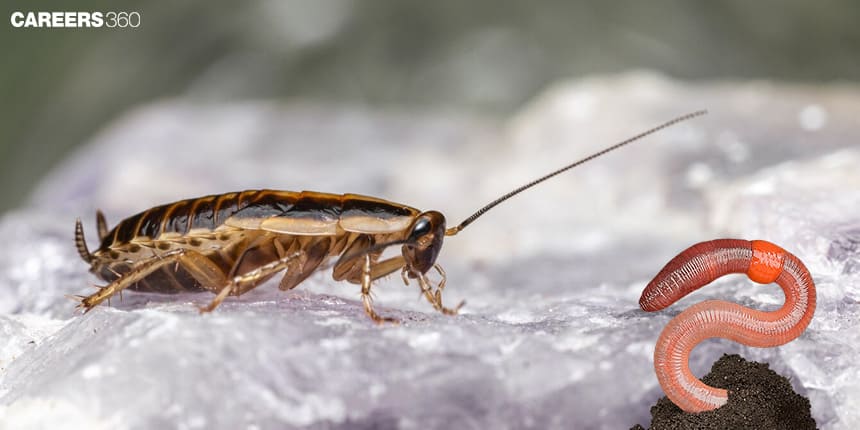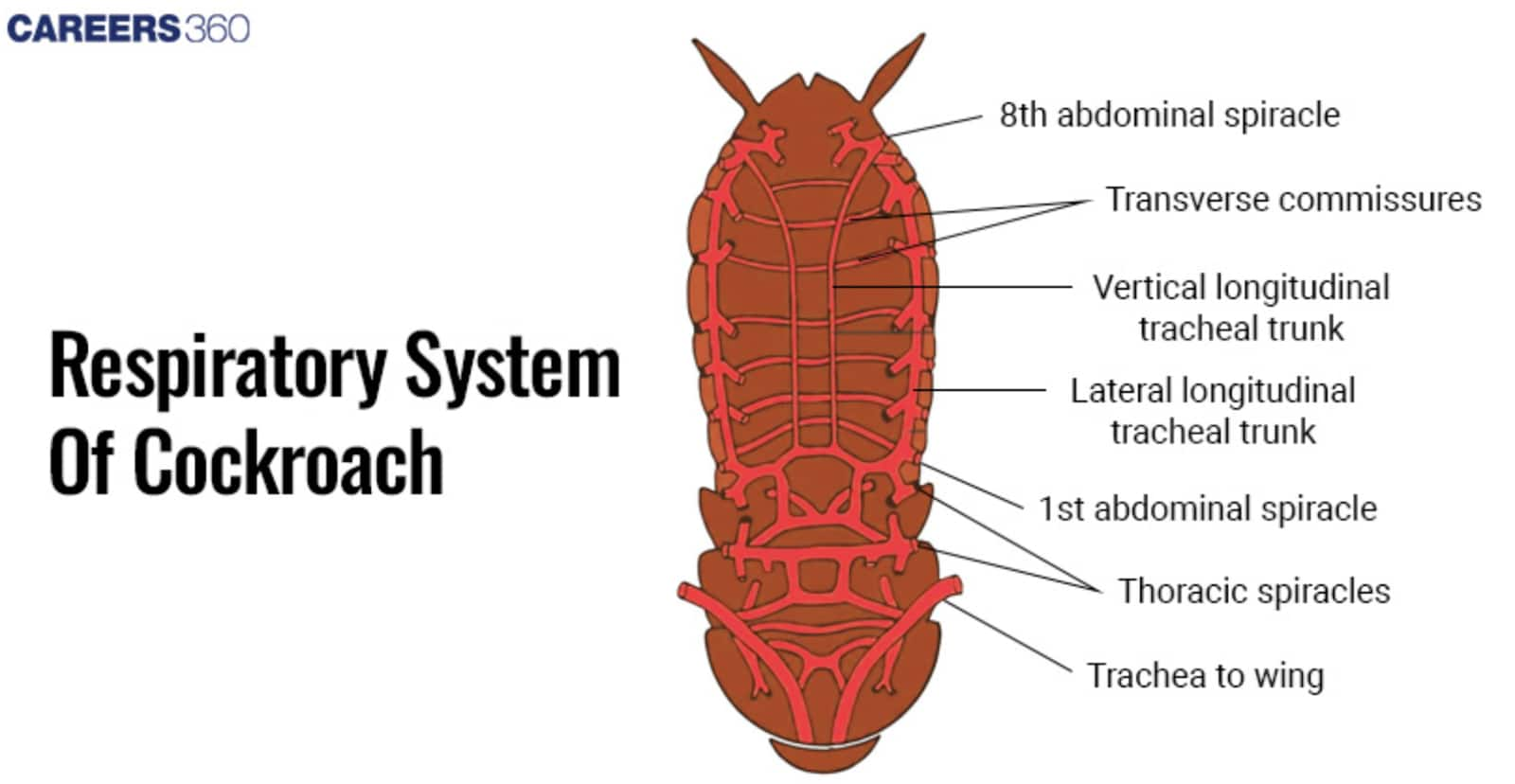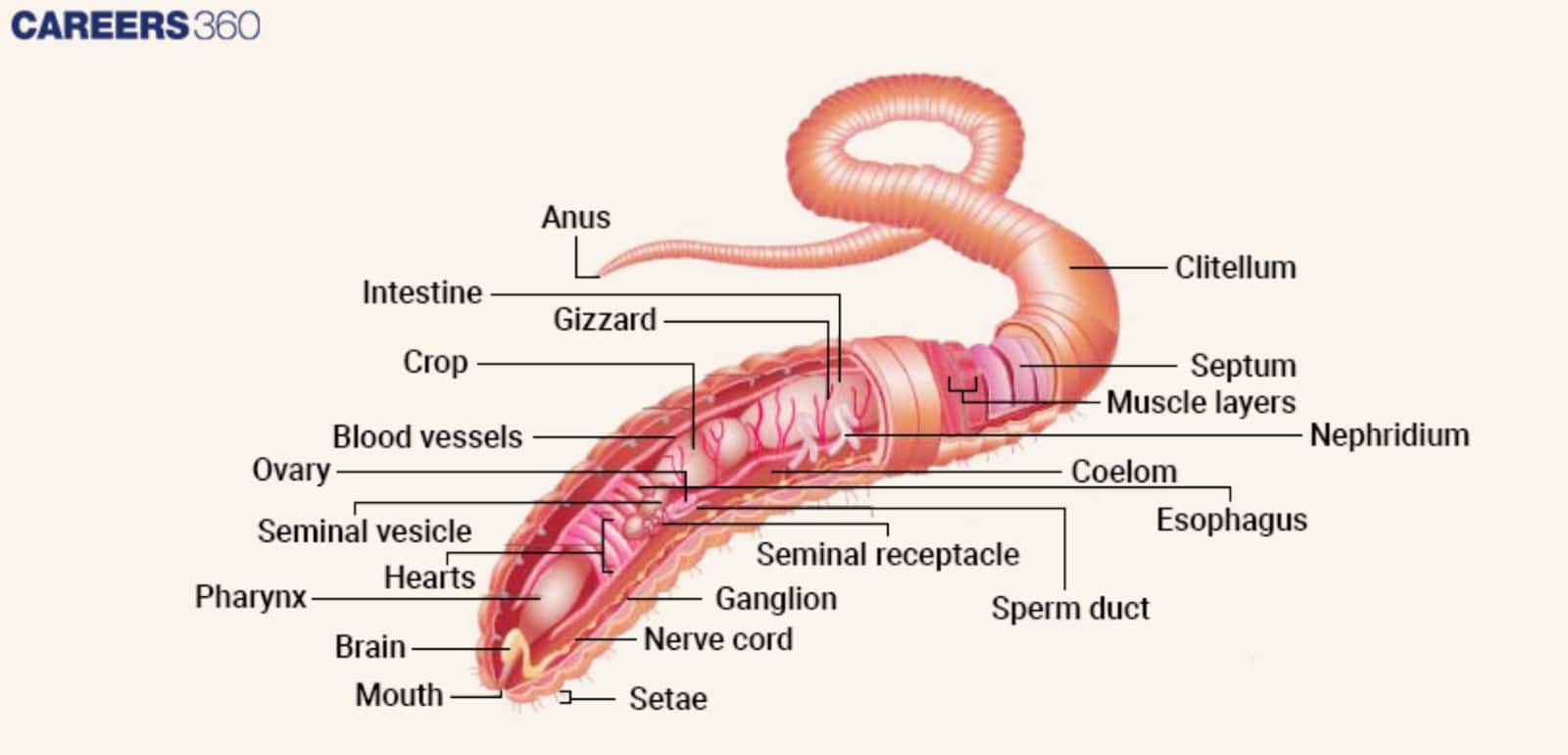Respiration In Cockroach And Earthworm: Definition, Meaning, Methods, Benefits,
Respiration in cockroaches and earthworms is different from each other. Respiration in animals like cockroaches and earthworms helps students understand different respiratory adaptations in organisms. Cockroaches breathe through a network of tubes called tracheae that transport oxygen directly to their tissues. Earthworms, on the other hand, absorb oxygen through their moist skin. This topic is from the class 11 chapter Structural Organisation in Animals of Biology.
NEET 2025: Mock Test Series | Syllabus | High Scoring Topics | PYQs
NEET Important PYQ's Subject wise: Physics | Chemistry | Biology
New: Meet Careers360 B.Tech/NEET Experts in your City | Book your Seat now
- Respiration in Cockroach and Earthworm
- Respiration in Cockroach
- Respiration in Earthworm
- Difference Between Respiration System of Cockroach and Earthworm

Respiration in Cockroach and Earthworm
Respiration is the process by which living organisms take in oxygen and release carbon dioxide to produce energy from food. It can occur through various methods, such as breathing, cellular processes, or diffusion across membranes.
Insects breathe through a system of tubes called tracheae that deliver oxygen directly to their bodies. These tubes open to the outside through small holes called spiracles. Worms, like earthworms, absorb oxygen through their skin and release carbon dioxide. For respiration, they need to stay moist, as the oxygen diffuses more easily through wet skin. Both insects and worms have adapted unique ways of breathing to survive in their environments.
Cockroaches and earthworms are two very different types of invertebrates on land with their special features and responsibilities. Cockroaches are survival general roaming insects, which can easily become adapted to any environment, and worms on the other hand are providers of good soil by digging and enhancing nutrient cycling.
Also Read:
- Practice MCQ on Respiration in Cockroach
- Earthworm Scientific Name
- Structural Organisation in Animals
- Breathing and Exchange of Gases
Respiration in Cockroach
Cockroaches are insects known for their flat, oval-shaped bodies and long antennae. They are scavengers, commonly found in various environments, and play a role in breaking down organic matter in ecosystems. Respiration in cockroach is described below:
Anatomy of Cockroach Respiratory System
In this case, the main respiratory system in the cockroach is the tracheal system where there is a network of tubes called the trachea for the exchange of gases. These tracheal tubes stretch throughout the organism’s length and connect into narrower tracheoles where oxygen is supplied to cells.
The respiratory system of a cockroach is defined more by the ability to supply oxygen to the tissues and other organs and does not include the lung air that is inhaled through small openings called spiracles, which are found on the sides of the thorax and abdomen. From these spiracles, air moves to the tracheal system which delivers oxygen to the cells with the help of the moist walls of the tracheoles. This direct delivery system makes it possible for the cockroaches to receive oxygen fast and expel carbon dioxide at a faster rate, facts that make them adaptable to most terrestrial habitats.
Diagram of cockroach respiratory system

Respiratory Organ of Cockroach
Cockroaches have evolved several structural adaptations to increase their respiratory efficiency:
Structural Adaptations
Tracheal System: Based on their respiratory system, the cockroach has a tracheal system that has tubes which directly supply tissue with air. This system enables easy exchange of gases within the body contrary to the respiratory system organs like the lungs.
Spiracles: These are small holes for coordinating the entry and exit of air into/from the tracheal system, and positions on the thorax and abdomen. These spiracles can be opened and closed by cockroaches to regulate how much water is let out and how much fresh gas is taken in.
Moist Tracheal Walls: The walls of the tracheal tubes are always wet so that the exchange of gases (oxygen and carbon dioxide) through them is easy. This has been a major adaption to enable them to perform rapid gas exchange which is vital for their existence in such settings.
Behavioural Adaptations
Nocturnal Activity: Most cockroaches are night active, this is because when their environment is dry or hot the body loses water. This behavior helps them avoid wastage of moisture and at the same time retains efficiency in their respiratory tracts.
Burrowing: Some of the species make burrows especially when the environment is dry, or extreme conditions are present. This behaviour helps them control the environment around them to ensure that conditions suitable for respiration are created.
Fast Movement: Cockroaches can walk or run rapidly to find a favourable environment such as a humid environment that favours efficient gas exchange via the tracheal system.
Mechanism of Respiration in Cockroach
Cockroaches breathe using a structure called tracheae which is connected to other structures known as spiracles; this enhances the efficient exchange of gases right across the body.
Inhalation and Exhalation Process
An advanced feature of the bodies of cockroaches is that they do not possess lungs, they breathe through a system of tubes known as tracheae. When the organism inhales, spiracles which are small holes on the outer surface of the thorax and abdomen become opened to admit fresh air into the tracheal system. The oxygenated air enters the spiracles and into the tracheal tubes which later subdivide into smaller tracheoles that reach out and supply oxygen to individual cells. Respiration is an inactive process done through spiracles, this also concerns the exhalation.
Role of Spiracles and Tracheae
Spriracles are the openings or the points where the cockroach takes air into its respiratory system. They control the amount of fresh air that is allowed into the nest as well as preventing water loss by opening or closing as required. Tracheae are the major tubes for the transportation of oxygenated air within the body via spiracles into different parts of the body. It splits into finer tracheoles, which get into the tissues and organs of the body and provide a means for exchanging gases through the moist inner lining. This direct kind of oxygen delivery makes for efficient respiration without having a circulatory system that is solely used for oxygen transport.
Gas Exchange in Cockroach
Breathing in cockroaches takes place through a network of tracheal system, oxygen diffuses to the cockroach while carbon IV oxide diffuses out of the cockroach.
Process of diffusion
Oxygen from the environment is taken through spiracles that are situated on the thorax and abdomen leading into a series of tracheal tubes that branch in the body. Carbon dioxide also exits through the same spiracles.
Exchange of Gases in Tracheal Tubes
Oxygen moves through wet walls of tracheae into smaller tracheoles that enter the tissues and bring oxygen into the cells. At the same time, the carbon dioxide produced as a result of cellular respiration moves out of cells and into tracheoles; spiracles expel this during exhalation.
Also Read:
| Nervous System of Earthworm | Excretory System of Earthworm |
| Circulatory System of Earthworm | Digestive System of Earthworm |
| Digestive System of Cockroach | Circulatory System of Cockroach |
Respiration in Earthworm
Earthworms are small, tube-shaped animals that live in soil. They help make the soil healthy by breaking down dead plants and mixing the soil, which helps plants grow better.
The process of respiration in earthworms is described below:
Anatomy of Earthworm Respiratory System
Earthworms lack gills and lungs, they breathe mainly through the skin, although some species breathe through their mouth.
Earthworms breathing in this way do not possess organs which are earmarked as lungs or gills. Although they possess lungs and a circulatory system, they breathe through their skin that is thin, and moist through gills, thus exhaling carbon dioxide. The skin is fairly permeable to gases and the babies can breathe oxygen from the environment while expelling carbon dioxide from their body.
The skin secretions known as mucous help to maintain the moisture of the outer cover of the earthworm and at the same time assist in respiration. In this case, it guarantees that the skin provides the skin with the necessary porosity to allow the diffusion process to occur for the gases that are vital for the survival of these animals.
Diagram of Earthworm respiratory system

Mechanism of Respiration in Earthworm
These small worms have rather moist skin through which they need to breathe, which is an essential activity for these creatures inhabiting terrestrial habitats.
Gas Exchange through Skin
The earthworms use diffusion to take in oxygen (O2) through the skin and out through the skin is carbon dioxide (CO2). Oxygen dissolves in the blood and the skin of the earthworm is thin and moist so oxygen diffuses into the earthworm’s skin. At the same time, globules of carbon dioxide generated by the course of cellular processes dissolve in the blood and are expelled into the atmosphere.
Importance of Moist Skin
Because gases tend to engage in minimal dissolution with the earthworm’s skin, the skin must always be moist. The presence of moisture on the skin surface makes sure that absorption of the gases to be diffused through the skin membrane takes place. This condition is drained and maintained by the mucous secretion from glands that are spread all over the body of the earthworm. These secretions are mainly involved in the process of ensuring that the skin is well-lubed so that it does not dry up.
Gas Exchange in Earthworm
In earthworms, respiration is mainly through the diffusion of gases, which takes place across the moist skin to capillaries that lie immediately beneath the skin.
Process of diffusion
While respiration in earthworms occurs through the skin, oxygen (O2) dissolves through the skin while carbon dioxide (CO2) diffuses out of the body. The oxygen from the soil or water around the worms diffuses through the wet skin of the earthworm and gets into the bloodstream. On the other hand, the carbon dioxide generated from the process of cellular respiration expires in the bloodstream through the process of diffusion.
Exchange of Gases through Capillaries under the Skin
Small vessels of blood that make immediate contact with worms' skin are called capillaries, which help in the exchanging of gases between the earthworm and the external atmosphere. Oxygen dissolves from the surrounding into the capillaries, and then it circulates in the blood and is delivered to cells all over the earthworm’s body. Carbon dioxide generated through the process of cellular respiration in the cells diffuses into the capillaries and is expelled out through the skin.
Adaptations for Respiration in Earthworms
Earthworms possess several structural adaptations that optimize their respiratory efficiency:
Structural adaptations
Moist, Permeable Skin: The skin of earthworms is thin, smooth, wet and especially, it is capable of allowing gaseous substances to diffuse through it. This enables easy transfer of oxygen and carbon dioxide through the skin layer or epidermis. Sweat it says enhances the exchange of gases while at the same time ridding the skin from excessive drying.
Capillary Network: Despite this earthworms have a capillary system which helps in moving gases from one cell to the other. Oxygen from the surrounding penetrates spaces between endothelial cells into the plasma of the capillaries; carbon dioxide, a product of tissue cell respiration, enters the tissue spaces from the blood in the capillaries.
Surface Area: The earthworm has a rather lengthy and flat body and this flat structure for its large part provides much more area for the effective gaseous exchange than in the case of the tubular body shape.
Behavioural Adaptations
Earthworms exhibit behavioural adaptations that support their respiratory needs:
Burrowing Behavior: Earthworms live in moist soil and they respire through their skin hence they need to be in an environment that has a high oxygen content in the soil. They change their position in the body and in the soil generally to manage their access to the air and then the oxygen and keep on changing between the two to balance between access and loss of gases through their skin.
Nocturnal Surface Activity: Some species of earthworm are known to be active at night especially when the environment is moist to enable them to expose their bodies to the soil’s surface to carry out gas exchange and at the same time can reduce water loss through the skin.
Response to Dry Conditions: During dry periods in the ground, earthworms move deeper in the soil, or enter a state of aestivation where they create a slimy cover to conserve water and avoid getting dehydrated as this affects their respiration.
Difference Between Respiration System of Cockroach and Earthworm
The major difference between Respiration process in Cockroach and Earthworms is given below:
Respiratory Structure | Tracheal System (Insects) | Skin Respiration (Earthworms) |
Organism Examples | Insects such as cockroaches, grasshoppers, beetles | |
Description | Network of tracheal tubes delivering air directly to tissues | Gas exchange occurs directly through the moist skin |
Presence of Organs | No specialised respiratory organs like lungs | No specialised respiratory organs like lungs |
Mechanism | Air enters through spiracles, travels through tracheae to tracheoles | Oxygen and carbon dioxide diffuse through the skin |
Surface Area | Large surface area for gas exchange | The surface area of the body is used for gas exchange |
Moisture Requirement | Moisture is not required for gas exchange | Skin must remain moist for efficient gas exchange |
Efficiency | Efficient for rapid gas exchange due to direct delivery of oxygen | Efficient for small organisms with low metabolic rates |
Adaptation to Environment | Allows for efficient gas exchange in diverse habitats | Suited for terrestrial habitats with moist environments |
Behavioural Adaptations | Control of spiracle opening and closing for water conservation | Behaviorally adjusts depth in soil for optimal conditions |
Recommended Video:
Frequently Asked Questions (FAQs)
Cockroaches have a disposition to breathe through tracheae; a part connected by a system of tubes. It gets into the body through little holes known as spiracles and moves through these tubes, in this process, oxygen is transported to the cells and carbon dioxides are expelled through the same channels.
Spiracles are different small pores found on the lateral sides of the cockroach’s body through which the air is allowed to pass through to the tracheal system. They control the amount of air that enters the respiratory system, reduce the amount of water that evaporates and also assist in the exchange of gases.
Earthworms have an external gill system through which they breathe with the help of moist skin through the process of diffusion. As for respiration, the combination of the surrounding oxygen dissolves through its skin onto layers of minuscule capillaries beneath which disperse it throughout the rest of the organism. Carbon dioxide which is the byproduct of the cellular respiration process is eliminated through the skin to the surroundings.
These aspects include respiratory systems namely the tracheal system which is long branched and can facilitate diffusion to enable gases to diffuse at fast rates. They can open or close spiracles as a means of preventing water loss or creating the best respiratory conditions depending on the surroundings.
Another reason why moisture is important to these worms that use skin is the only known organ through which these worms can breathe through diffusion. This is the reason why terrestrial ecosystems, need to have moisture on the skin surface so that gases – oxygen and carbon dioxide can dissolve and pass through to allow the necessary respiration which is vital for their survival.
Also Read
02 Jun'25 02:03 AM
29 May'25 04:30 PM
26 Nov'24 04:23 PM
26 Nov'24 04:19 PM
